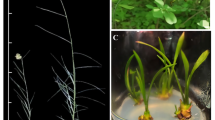Abstract
Thalli of the economically important rhodophyteGelidium sesquipedale were cultured for 8 weeks under laboratory conditions, and the influence of temperature and photoperiod on the re-attachment process were studied. Four different temperatures (16, 18, 20, 22 °C) and four different photoperiods (6:18, 12:12, 14:10, 16:8) were used and the results obtained in the thalli responses such as apical growth (measured as elongation of principal apex), rhizoidal cluster production and number of necrotic patches were tested.
During the re-attachment process, the best results were obtained at temperatures of 16–18 °C, when rhizoidal cluster production was high and necrotic patch development was low (18 °C) or absent (16 °C). Temperatures of 20 and 22 °C favoured high rhizoidal cluster production, but also a high production of necrotic patches that finally led to death. The results suggest that long-day photoperiods (14:10, 16:8) produce a higher number of rhizoidal cluster bands than short-day photoperiods (6:18) at the same temperature.
Similar content being viewed by others
References
Akatsuka L (1986) Japanese Gelidiales (Rhodophyta) especiallyGelidium. Oceanogr. mar. biol. ann. Rev. 24: 171–263.
Amsler CD, Reed DC, Neushul M (1992) The microclimate inhabited by macroalgal propagules. Br. phycol. J. 27: 253–270.
Borja A (1992) La gestión de los recursos algales en el País Vasco: Comunidades naturales de Gelidium sesquipedale, cosecha de arribazones y recuperación tras explotación por arranque y corte. Inf. Tec. G.V. No. 44.
Brawley SH, Johnson LE (1992) Gametogenesis, gametes and zygotes: Ecological perspective on sexual reproduction in the algae. Br. phycol. J. 27: 233–252.
Correa J, Avila M, Santelices B (1985) Effects of some environmental factors on growth of sporelings in two species ofGelidium (Rhodophyta). Aquaculture 44: 221–227.
D'Antonio CM, Gibor A (1985) A note on the influence of photon flux density on the morphology of germlings ofGelidium robustum (Gelidiales, Rhodophyta) in culture. Bot. Mar. 28: 313–316.
Gorostiaga JM (1990) Aspectos demográficos del alga roja Gelidium sesquipedale (Clemente) Thuret. Discusión sobre su adecuada gestion como recurso explotable. Tesis Doctoral, Univ. del País Vasco. 313 pp.
Lüning K (1981) Light. In Lobban CS, Wynne MJ (eds), The Biology of Seaweeds. Blackwell Scientific Publications, London, 326–355.
Macler BA, West JA (1987) Life history and physiology of the red algaGelidium coulteri in unialgal culture. Aquaculture 61: 281–293.
Macler BA, Zupan JR (1991) Physiological basis for the cultivation of the Gelidiaceae. In Juanes JA, Santelices B, McLachlan JL (eds), International Workshop onGelidium. Developments in Hydrobiology 68. Kluwer Academic Publishers, Dordrecht, 83–90. Reprinted from Hydrobiologia 221.
Okamura K (1934) OnGelidium andPterocladia of Japan. Tokai University Press, Tokio, 185 pp.
Oliger P, Santelices B (1981) Physiological ecology studies on chilean Gelidiales. J. exp. mar. Biol. Ecol. 53: 65–75.
Ruennes J, Fredriksen S (1989) Field and culture studies ofGelidium latifolium (Grev.) Born. and Thur. (Rhodophyta) from Norway. Sarsia 74: 177–185.
Ruennes J, Fredriksen S (1990). Field and culture studies ofGelidium (Gelidiales, Rhodophyta) from their northern limit of distribution in Europe. In Lindstrom SC, Gabrielson PW (eds), Thirteenth International Seaweed Symposium. Developments in Hydrobiology 58. Kluwer Academic Publishers Dordrecht, 419–424. Reprinted from Hydrobiologia 204/205.
Salinas JM (1991) Spray system for re-attachment ofGelidium sesquipedale (Clem.) Born. et Thur. (Gelidiales: Rhodophyta). In Juanes JA, Santelices B, McLachlan JL (eds), International Workshop onGelidium. Developments in Hydrobiology 68. Kluwer Academic Publishers, Dordrecht, 83–90. Reprinted from Hydrobiologia 221.
Santelices B, Varela D (1991) Abiotic control of reattachment in Gelidium chilense. IV Congreso Latinoamericano de Ciencias del Mar. Coquimbo (Chile) (30 Sep–4 Oct), 19 pp.
Seoane-Camba JA (1989) On the possibility of culturing Gelidium sesquipedale by vegetative propagation. In Kain JM, Andrews JW, McGregor BJ (eds), Proceedings of the Second Workshop of COST 48, Subgroup 1: 59–68.
Sokal RR, Rohlf FJ (1969) Biometry. WH Freeman and Co., San Francisco, 832 pp.
Torres M, Niell FX, Algarra P (1991) Photosynthesis ofGelidium sesquipedale: effects of temperature and light on pigment concentration, C/N ratio and cell-wall polysaccharides. In Juanes JA, Santelices B, McLachlan JL (eds), International Workshop onGelidium. Developments in Hydrobiology 68. Kluwer Academic Publishers, Dordrecht, 83–90. Reprinted from Hydrobiologia 221.
Vadas RL, Johnson S, Norton TA (1992) Recruitment and mortality of early post-settlement stages of benthic algae. Br. phycol. J. 27: 331–351.
Zar JH (1984) Biostatistical analysis. Prentice-Hall International, New Jersey, 718 pp.
Author information
Authors and Affiliations
Rights and permissions
About this article
Cite this article
Salinas, J.M., Valdés, L. Influence of temperature and photoperiod on the re-attachment process ofGelidium sesquipedale (Clem.) Born. et Thur. (Gelidiales: Rhodophyta). J Appl Phycol 5, 317–326 (1993). https://doi.org/10.1007/BF02186234
Received:
Revised:
Accepted:
Issue Date:
DOI: https://doi.org/10.1007/BF02186234




